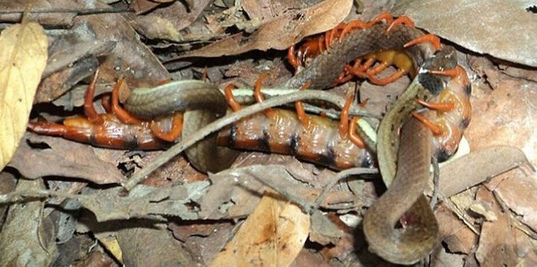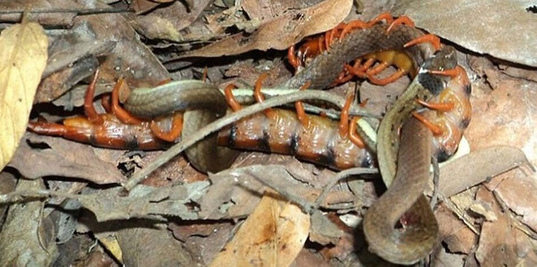Trace 'dick' to grab the chance to attack the snake which is laying eggs
Taking advantage of the female snake that is laying eggs, the moment it is most vulnerable, the big 'wise' centipede shoots the opportunity to quickly attack, knock it down and turn it into a nutritious meal.
- At the end of the battle of death, the poisonous tiger was swallowed by the king's snake
- The small snake desperately took the last breath from the frog's throat
- Giant centipedes and mantis: poisonous species and 'martial' species, who wins?
Biologists at the Sakaerat Environmental Research Station in Thailand have recorded an image of a centipede attacking and eating a spawning snake.

Use the foot with the poisonous nails to grip the snake.(Photo: Science Alert.)
Scientists identified this centipede as Scolopendra dawydoffi centipede. This is a large and aggressive centipede. They are common in Southeast Asia. The snake belongs to the black-headed triangle snake Sibynophis triangularis.
The food of Scolopendra dawydoffi centipede not only contains insects but also many small vertebrates. Scientists have encountered the case of Scolopendrid centipedes that re-nourish pups, lizards, bats, and even birds.
The team said that when they discovered the centipede, it used its legs to tighten it around the snake. It stabbed poisonous nails into the snake so that the prey could not move.
The snake has just finished laying three eggs and there are two more left in the body to be attacked.

The snake cannot struggle due to being injected with poison from the centipede's leg.(Photo: Cosmos Magazine.)
This is the first time it has been recorded that a centipede case attacks an egg-laying vertebrate. According to the team, giant centipedes can eat vertebrates more often than scientists once thought, because compared to crickets or beetles the amount of nutrients from snakes or toads is much greater. .
You should read it
- Shivered with the terrifying behavior of the giant centipede, eating the main meat 'self' after molting!
- Giant centipedes catch bats in the cave
- Multi-legged robot inspired by centipede
- Going on the wrong road, the rat snake is re-eaten by the tiger with the lord
- Terrifying spectacle: Giant spider cuts solid meat
- 'Immune to poison' These 7 predators eat poisonous snake meat as easily as ... 'eat candy'
- Discovering new snakes, whole body covered with strange sparkling gold
- The ultimate snake surgery of the tall bird is called the 'Taekwondo killer'.
- The small snake desperately took the last breath from the frog's throat
- Working hot on the screen, sneaking out on Facebook, have you tried it?
- Jade snake snake - Beauty queen snake in Vietnam
- How to create snake skins in game slither.io
May be interested

Where is the shortest river in the world, how many meters long?

Thought about to have a hearty meal, flying lions biting giraffes and bitter endings

Celebrate the world's most intelligent dogs

Hybrid between giant spiders and scorpions, this furry exotic creature is the fear of many people

Herd of goldfish is as big as a disc, which is dangerous to the city of Canada

The civet jumps and pulls the poisonous serpent corpse on the tree to eat meat






 South American monsters - Spawn anaconda or spawn?
South American monsters - Spawn anaconda or spawn? Going on the wrong road, the rat snake is re-eaten by the tiger with the lord
Going on the wrong road, the rat snake is re-eaten by the tiger with the lord Discovering new snakes, whole body covered with strange sparkling gold
Discovering new snakes, whole body covered with strange sparkling gold How to find Grab trips with invoices
How to find Grab trips with invoices Is egg yolk really beneficial or harmful?
Is egg yolk really beneficial or harmful? The ultimate snake surgery of the tall bird is called the 'Taekwondo killer'.
The ultimate snake surgery of the tall bird is called the 'Taekwondo killer'.